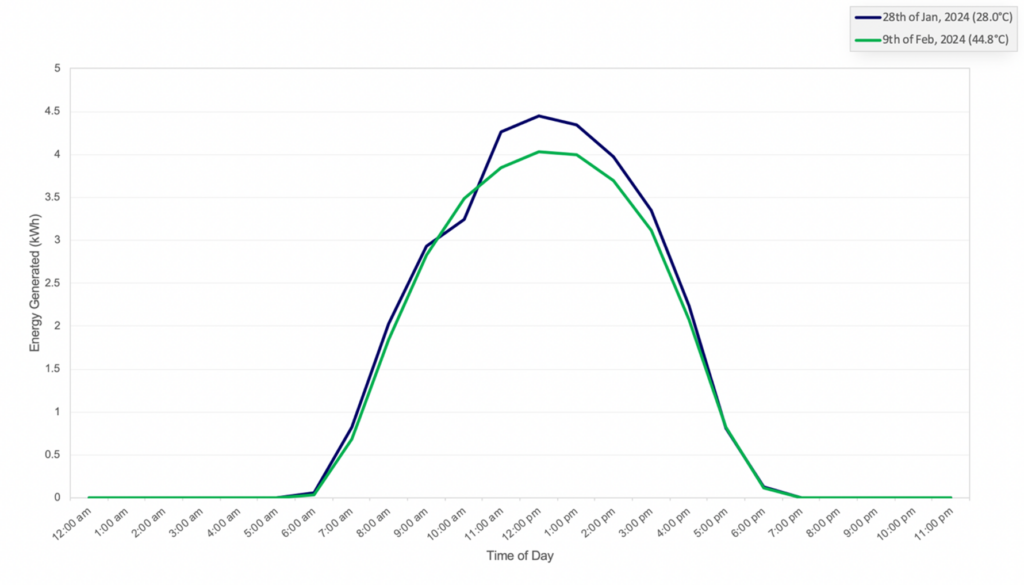The immediate effect of rising global temperatures on solar panels’ long-term viability and efficiency. In this multi-part series, we delve into the challenges faced by solar panels and present solutions aimed at amplifying the generation of renewable energy.
For quite some time, solar energy has been seen as a hopeful renewable energy option, presenting a clean alternative to non-renewable fossil fuels. But despite their promising nature, the rising temperatures – caused by climate change – have had a notable impact on the efficiency and long-term viability of solar panels.
Excessive heat causes solar panels to experience a decrease in efficiency and performance. Studies have shown that there is a direct proportionality between temperature, output current and efficiency of the solar panel – high temperatures reduce the efficiency of converting sunlight into electricity.
When buying solar panels in Australia, it’s crucial to take into account the temperature coefficient, an important value that will be listed on your panel’s datasheet. This coefficient indicates the percentage by which efficiency will decrease for every 1°C above 25°C. This temperature coefficient typically ranges between a 0.2% and a 0.5% decrease.
To give context, let’s consider the Suntech 280W, with a temperature coefficient of 0.41%. On a 40°C day, efficiency is projected to drop by at least 6%, and on these hot days, the roof temperature can reach up to 30 degrees hotter than the temperature observed at weather stations, dependent on the time of day and the construction of the roof.
When comparing a hot day with a maximum of 44.8°C to an almost-ideal day at 28°C, it is expected that the effects of temperature would decrease efficiency by a maximum of 6.89%, during the hottest part of the day. However, in reality, the efficiency decrease was measured to be 9.36%, during the hottest period. It is important to note that both days receive the same number of hours of sunlight.
As climate change grows worse, the frequency and severity of heatwaves are likely to increase, causing high temperatures and thereby compounding the problems for PV systems. These extreme temperatures will contribute to an increased demand for energy, particularly used for air-conditioning.
While solar energy offers a renewable solution to meet this growing energy demand, the reduction in efficiency due to the excessive heat conditions, will reap a greater reliance on other sources of energy, such as fossil fuels, to meet the escalating demand.

Figure 1: Effect of Temperature on Daily Solar Production
The connection between climate change, energy demand, and solar energy reliability produces a dangerous feedback loop. As temperatures rise, so does the need for electricity due to increased demand on air-conditioning and other cooling appliances, increasing our reliance on solar energy. However, if solar panels fail due to extreme heat, there will be a greater reliance on other energy sources, which will further contribute to future temperature increases. The solution is – this cycle must be broken.
Don’t miss the next part, where we will propose some solutions to the challenges discussed in this article.
Calculations
To determine the reduction in maximum efficiency, we computed the impact of a temperature increase of 3°C from the standard operating temperature of 25°C. This adjustment, based on the temperature coefficient, yielded a reduction of 1.23%. Subsequently, considering a temperature difference of 44.8°C above the standard operating temperature of 28°C was equal to 16.8°C, thus the estimated efficiency decrease was determined to be 6.89%.
Analysing the energy production over a one-hour period, specifically at 12:00 PM, the peak temperature, we observed that under ideal conditions, the solar panels generated 4.45 kWh of energy. However, on the day with extreme temperatures, the energy output decreased to 4.03 kWh. Consequently, the calculated efficiency decrease amounted to 9.36%. It’s crucial to remember that these percentages only apply at certain periods of the day; because of Geraldton’s weather, the differences are negligible for much earlier and later in the day. Due to the heat island effect, in the city, you will find that it is usually hotter for longer and thus these efficiency reductions may be more prevalent for longer.
References
Dubey, S., Sarvaiya, J. N., & Seshadri, B. (2013). Temperature Dependent Photovoltaic (PV) Efficiency and Its Effect on PV Production in the World – A Review. Energy Procedia – Volume 33, 311-321. Retrieved from https://www.sciencedirect.com/science/article/pii/S1876610213000829
Henderson, M. (2024). The Effect Of Temperature On Solar Panel Performance. Retrieved from Solar Calculator: https://solarcalculator.com.au/solar-panel-temperature/
Bureau of Meterology (2024, February). Geraldton, Western Australia Daily Weather Observations. Retrieved from Bureau of Meterology: http://www.bom.gov.au/climate/dwo/IDCJDW6048.latest.shtml
Santillán-Soto, N. (2023). Air Temperature Variations Due to Different Roofs and Their Impact on Energy Consumption and Emissions: Mexicali University Campus Case Study. Urban Microclimate: Thermal Comfort, Air Quality and Green Building as Drivers of Healthy Urban Design.
